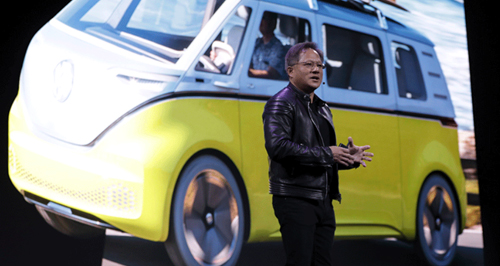Make / Model Search
News - General News - Autonomous TechnologyCES: Nvidia details autonomous driving challengesTight fit: Nvidia CEO Jensen Huang shows off the Drive Xavier, a powerful but efficient autonomous vehicle processor that fits on a board smaller than a registration plate. Despite challenges, Nvidia Drive Xavier processor set to power autonomous cars9 Jan 2018 TECHNOLOGY giant Nvidia kicked off the 2018 Consumer Electronics Show (CES) in Las Vegas overnight with several automotive announcements, including its take on the state of autonomous vehicles. Speaking at a media event, Nvidia chief executive officer Jensen Huang detailed why his company believed “the complexity of autonomous driving, the complexity of the software of future cars is incredible”. “Now, we’ve built PCs, laptops, game consoles, supercomputers, and I can tell you, without exception, building a computer for autonomous vehicles is of a level of complexity the world has never known,” he said. Mr Huang explained that the computer needs to be constantly alert, foolproof and able to decipher information from multiple sensors concurrently, making it an engineering exercise not encountered before. “This computer is on all the time, monitoring all of the sensors that are coming at it – it can never fail, it can never fail, because lives are at stake,” he said. “And it has to make the right decision, running software the world has never known how to write.” Nevertheless, after four years of development and a $US2 billion ($AU2.55 billion) investment, a team of more than 2000 Nvidia engineers has created the most advanced System on a Chip (SoC) processor yet. “It starts with, of course, building a brand new type of processor we call the Drive Xavier – an autonomous machine processor that is able to do deep learning, perception, has the ability to do parallel computing, and also computer vision and high-performance computing at very, very energy-efficient levels,” Mr Huang said. Capable of completing 30 trillion operations per second while consuming only 30 watts of power, Xavier features more than nine billion transistors but is 15 times more efficient than its predecessor. Significantly, the new processor fits on a board smaller than a registration plate, meaning the cargo areas of the next generation of autonomous vehicles will not be filled up with computing gear. The first samples of Xavier will be sent to select customers in the first quarter, just over a year after it was first announced. Mr Huang also stressed the importance of autonomous vehicle development, given it will underpin the evolution of everyday mobility in the coming years, with Artificial Intelligence (AI) to play a significant role in this. “In the future, every car will be self-driving. There will be 100 million cars built each year, millions of robotaxies and several hundred thousand trucks,” he said. “All of it will be autonomous. On top of this, what will define the driving experience is the AI.” According to Mr Huang, AI will be transformational for the automotive industry as it helps to improve the value proposition of autonomous vehicles over traditional models. “We believe that AI can eventually drive the cost per mile of autonomous vehicles to essentially the same level, if not below, that of owned cars – self-driven cars,” he said. “So when that happens, it’s possible, we believe, that AV (Audio Visual) could revolutionise mobility services.” Nvidia now has a trio of AI software platforms under its Drive banner, including the brand-new Drive IX and Drive AR (Augmented Reality), which join the existing Drive AV that uses neural networks to let cars drive themselves. Drive IX enables AI assistants for both drivers and passengers via sensors inside and outside of the vehicle, while Drive AR delivers information about points of interest, creates alerts, and helps to navigate safely and easily. The former will be employed by Volkswagen as it moves towards introducing autonomous cars to global markets, while ride-sharing service Uber will use select Nvidia technologies in its fleet of self-driving vehicles – including cars and trucks. Furthermore, automotive supplier ZF and China-based web services company Baidu will collaborate with Nvidia to create a production-ready AI autonomous-vehicle platform based on Nvidia Drive Xavier, ZF ProAI and Baidu Apollo Pilot. Similarly, mobility startup Aurora will also partner with Nvidia, aiming to develop its own modular and scalable Drive Xavier platform for autonomous vehicles.  Read more6th of April 2017  Audi and Porsche to share vehicle architectureVW Group siblings commit to architecture, EV and autonomous co-development6th of January 2017  CES: Autonomous tech steals the showTop car-makers rollout latest self-driving systems in Las Vegas20th of May 2016  Powerful US lobby pushes driverless car causeUS energy security council calls for law reform to boost autonomous car sector |
Click to shareGeneral News articlesResearch General News Motor industry news |












Facebook Twitter Instagram